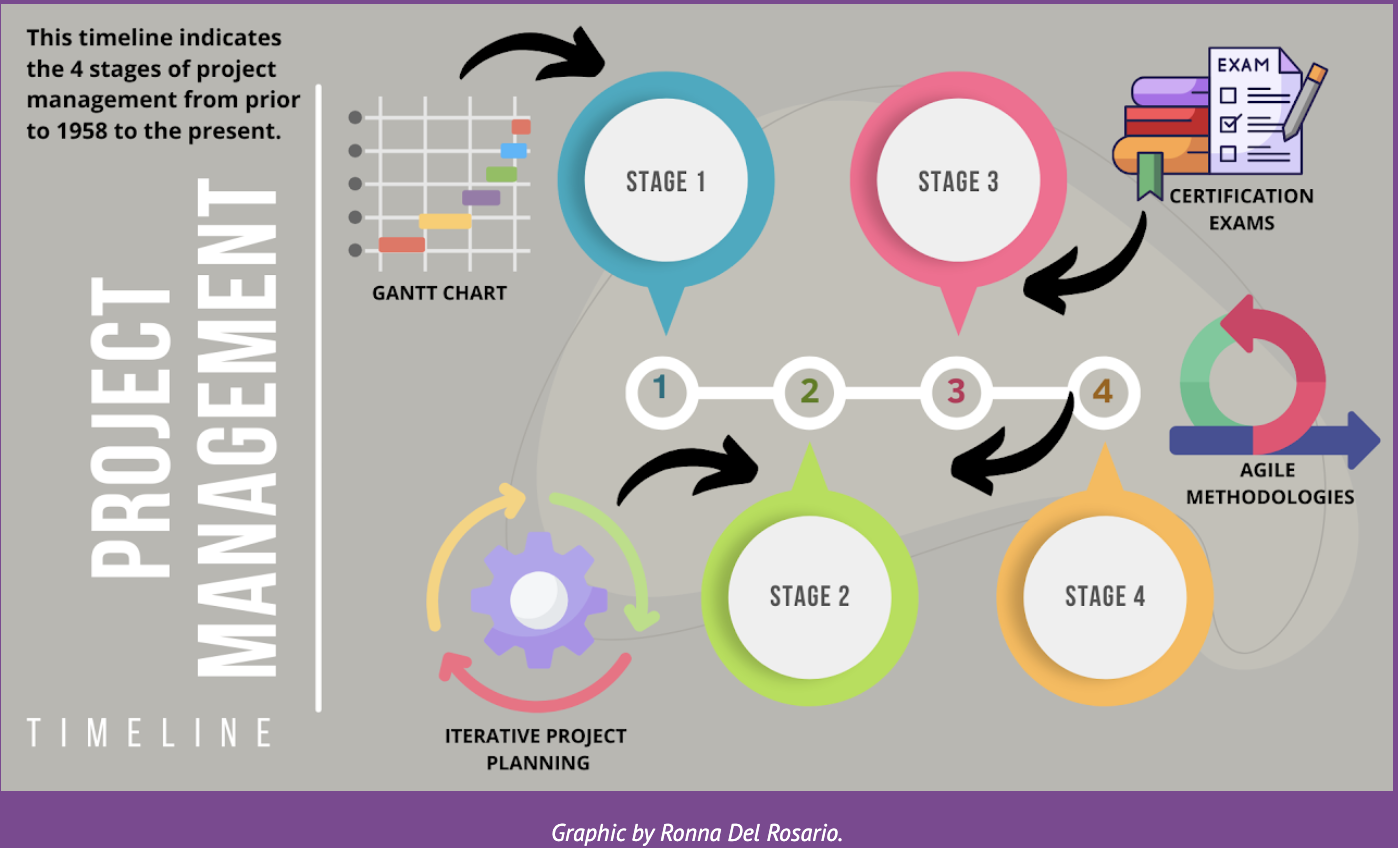Competency E
Work collaboratively in teams and use project management practices effectively to solve user-centric information and data problems.
Introduction and PLO Discussion
Project management professional Joy Gumz said, “Operations keeps the lights on, strategy provides a light at the end of the tunnel, but project management is the train engine that moves the organization forward.” The aforementioned quote highlights the notion that project management is extremely vital to the successful functioning of our modern and technologically-driven world.
Definition and Stages of Project Management
So, what exactly is project management? According to the Association for Project Management (n.d.), project management is “the application of processes, methods, skills, knowledge, and experience to achieve specific project objectives according to the project acceptance criteria within agreed parameters.” What truly distinguishes project management from “management” is that project management entails a final deliverable and a finite timespan, whereas “management” is an ongoing process (Association for Project Management, n.d.).
The project management life cycle is comprised of the following five stages: 1. Initiation, 2. Planning, Execution, 4. Monitoring and Control, and 5. Closure (National University, n.d.). As the crucial first stage of the project management life cycle, Initiation “involves defining the project’s purpose, objectives, and scope, as well as identifying the clients and stakeholders and their needs (National University, n.d.). Next, Planning involves smart and thoughtful strategizing on how to best allocate resources to meet the client’s needs and project requirements all within a determined budget and timeframe. Execution sets work into motion as the project manager works with team members to assign tasks and responsibilities to them and as team members contribute to the team through their individual and collective efforts. Monitoring and Control are the vital fourth stage that exists to keep a project on track and on the road to meet its objectives often utilizing key performance indicators (KPIs). Lastly, closure is the final stage “where the teams complete all the remaining tasks and activities to bring a project to a successful conclusion (National University, n.d.).”
Benefits and Challenges of Project Management
When implemented in a consistent, thorough fashion, the integration of project management to one’s individual/team’s workload can reap a variety of the following benefits: 1. Greater operational efficiency, 2. Deadline compliance, 3. Improved communication, and 4. Adaption to changes (Actio, 2023). Greater operational efficiency occurs as a result of optimized resource allocation and waste mitigation. Deadline compliance becomes more achievable especially with the “checks and balances” that comes from the Monitoring and Control stage. Due to the emphasis on meticulous monitoring and documentation of progress, team members also experience improved lines of communication. Finally, when project management is successfully integrated into the workflow, the emphasis on Agile methodologies allows teams to better handle unforeseen and challenging circumstances that may crop up.
It goes without saying that there are also challenges that come within the realm of project management including structural rigidity, documentation overload, and resistance to change. Since structural rigidity may prove disadvantageous especially when circumstances come up that try a team’s flexibility and adaptability, the team should strive to strike a balance between structure and flexibility. To avoid documentation overload, documentation should be kept as clear and concise as possible and should be consistently, meticulously managed from the project’s start. Finally, introducing change management strategies and maintaining clear, open lines of communication are integral to combating resistance to change.
Relevant Coursework and Future Goals
In terms of the sources of my evidence, INFM 205: Informatics Project Management offered two straightforward examples to fulfill Competency E. Because many projects require collaboration with others, I selected the final video presentation that my fellow team members and I worked on for INFM 213: Epidemiological Methods. Since project management is such an integral component to the work of an individual or a team, I believe it is worthwhile to pursue further learning on the topic by taking the Google x Coursera Project Management Professional Certificate program. Continuing to develop and enhance my project management skills would assist me in becoming a valuable contributor wherever my next role takes me.
References
Evidence #1: INFM 205 - Final Project Well-Managed Website
For my first piece of evidence, I selected the final project Well-Managed a project management resource website I designed for INFM 205: Informatics Project Management. The concept behind the website was inspired by a desire to create a resource guide for graduate students on project management and how incorporating it within their program of study could greatly benefit them. The Well-Managed website is divided into 4 main areas: Background of Project Management, Benefits of Project Management, Project Management Tips, Recommended Applications and Software, and Musings.
For the Background of Project Management, I define project management and also shared a brief history as well as how project management has developed over the past several decades. In Benefits of Project Management, I provide 4 benefits of project management and how these benefits can impact students in the long run if incorporated. As for Project Management Tips, I list a 4-step strategy to approach and successfully complete projects. In Recommended Applications and Software, I discuss 4 tried and trusted tools that have been instrumental when working on projects for graduate school, extracurricular courses, or personal projects. Lastly, Musings provides personal insights through the following thoughtful blog articles: “3 Lessons I Learned in My First 8 Weeks of Grad School,” “Rising to the Challenge of Group Projects,” and “What Project Management Has Taught Me.”
Evidence #3: INFM 213 (Final Presentation)
Conclusion
Evidence #2: INFM 205 - (Project Management Strategy Essay)
Also derived from INFM 205: Informatics Project Management, I chose my Project Management Strategy Essay for my next piece of evidence. For this particular writing assignment, the aim was to discuss at least three specific ways that one can stay on track and increase the likelihood of successfully completing one’s project. I selected the following 3 strategies for enhanced project management: Defining Project Scope; Promoting Clear, Effective, and Open Communication; and Scheduling Routine Check-Ins.
For my final piece of evidence that fulfills Competency E, I am showcasing my group’s final video presentation for INFM 213: Epidemiological Methods. The goal for this presentation was to select a distinct population – in our case school-aged children – and introduce them to some epidemiology basics in an engaging format. The teaching schematic we selected to disseminate our foundational knowledge on epidemiology involved designating an epidemiological term for each letter of the alphabet and creating a video presentation detailing this informative adventure entitled “The As to Zs of Epidemiology.” We first determined the workload for each individual by dividing up the letter of the alphabet and randomly assigning a group of letters to each team member using a picker wheel. Once each group member had their individual assignment, each member was tasked to illustrate a way to explain the term for each of their letters paired with relevant visuals. To streamline our group’s creative ideation and design process, we utilized Adobe Express to work more collaboratively and efficiently. Once all the illustrations and narrations were completed, I combined audio and video and added captions, using Adobe Premiere Pro.
With Competency E’s emphasis on utilizing project management techniques, I decided it was worthwhile to include two of my assignments from INFM 205: Informatics Project Management. To highlight my cross-collaboration with others, I selected our team’s video presentation from INFM 213: Epidemiological Methods, especially as it was one of the projects that involved a decent amount of time management and project management in order for us to stay on task and successfully submit our project. Through these coursework examples and several others, I endeavored to complete throughout my Informatics journey, I have gained valuable skills in project management which I will be able to effectively apply in my next role.
Actio. (2023, December 28). Project management: Advantages and disadvantages. Actio Software. https://actiosoftware.com/en/project-management-advantages-and-disadvantages/
Association for Project Management. (n.d.) What is project management? Association for Project Management. https://www.apm.org.uk/resources/what-is-project-management/
National University. (n.d.). Why is project management important? National University.https://www.nu.edu/blog/why-is-project-management-important/


